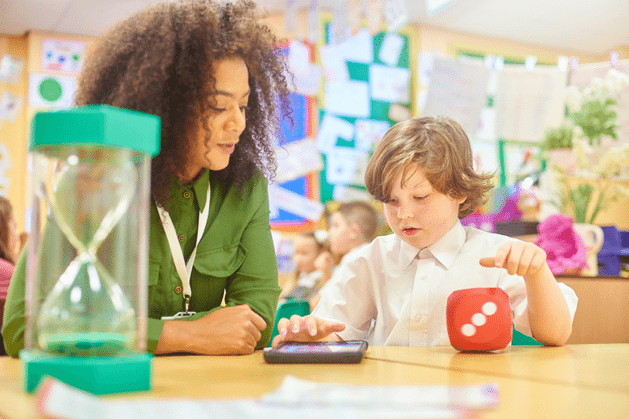11 Essential Strategies in Teaching Math
Even veteran teachers need to read these.
1. Raise the bar for all.
It can be a challenge to overcome the socially acceptable thought I was never good at math, says Sarah Bax, a math teacher at Hardy Middle School in Washington, D.C. Rather than being born with or without math talent, kids need to hear from teachers that anyone who works hard can succeed. “It’s about helping kids have a growth mindset,” says Bax. “Practice and persistence make you good at math.” Tell students about the power and importance of math with enthusiasm and high expectations.

2. Don’t wait—act now!
Look ahead to the specific concepts students are expected to master for annual end-of-year tests and pace instruction accordingly. “You don’t want to be caught off guard come March thinking that students need to know ‘x’ for the tests the next month,” says Skip Fennell, project director of Elementary Mathematics Specialists and Teacher Leaders Project and professor emeritus at McDaniel College in Westminster, Maryland. Know the specific standards and back map your teaching from the fall so students are ready. Several teachers we know love using the First in Math blended learning program to practice key skills along the way. (Psst … Right now, you can create a demo account to try out the tool for free.)
3. Create a testing pathway.
Use formative assessments to ensure that students are understanding the concepts. What you learn can guide your instruction and determine next steps, says Fennell. Testing is not something separate from your instruction. It should be integrated into your planning. Instead of a quick exit question or card, give a five-minute quiz to confirm students have mastered the math skill covered in the day’s lesson. A capable digital resource designed to monitor your students in real-time can also be an invaluable tool, providing actionable data to inform your instruction along the way.
4. Observe, modify, and re-evaluate.
Walk throughout your classroom as students work on problems and observe the dynamics. Talk with students individually and include “hinge questions” in your lessons plans to gauge understanding before continuing, suggests Fennell. In response, make decisions to go faster or slower or put students in groups.

5. Personalize and offer choice.
At Hardy Middle School, students use the First in Math online program. “Kids can individualize it for themselves because there is a great deal of choice,” says Bax. Students can select from different games that interest them—some are timed, others are not—learning to master foundational math standards in the process. As they move at their own pace, teachers can track understanding and tailor lessons accordingly, adds Bax.

6. Encourage math talk.
Engage students in conversations about their work and have them describe why they solved a problem in a certain way. “My goal is to get information about what students are thinking and use that to guide my instruction, as opposed to just telling them information and asking them to parrot things back,” says Delise Andrews, who taught math (K-8) and is now a 3-5 grade math coordinator in the Lincoln Public Schools in Lincoln, Nebraska. Instead of seeking a specific answer, Andrews wants to have deeper discussions to figure out what a student knows and understands. “True learning happens a lot around talking and doing math—not just drilling,” he says.
7. Seek to develop understanding.
Meaningful math education goes beyond memorizing formulas and procedures. Set high goals, create space for exploration, and work with the students to develop a strong foundation. “Treat the kids like mathematicians,” says Andrews. Present a broad topic, review various strategies for solving a problem, and then elicit a formula or idea from the kids rather than starting with the formula. This creates a stronger conceptual understanding and mental connections with the material for the student.
8. Choose meaningful tasks.
Kids get excited about math when they have to solve real-life problems. For instance, when teaching sixth graders how to determine area, present tasks related to a house redesign, suggests Fennell. Provide them with the dimensions of the walls and the size of the windows and have them determine how much space is left for the wallpaper. Or ask them to consider how much tile is needed to fill a deck.
9. Allow for productive struggle.
When giving students an authentic problem, ask a big question and let them struggle to figure out several ways to solve it, suggests Andrews. “Your job, as a teacher, is to make it engaging by asking the right questions at the right time. So you don’t take away their thinking, but you help them move forward to a solution,” she says. Provide as little information as possible but enough so students can be productive. Effective math teaching supports students as they grapple with mathematical ideas and relationships. Allow them to discover what works and experience setbacks along the way.

10. Build excitement and reward progress.
With First in Math, students earn points and receive certificates, stickers, badges, and trophies as they progress. Weekly announcements and assemblies celebrate the top players and teams. “Seeing their name up next to the word genius … having that recognition and moment is powerful,” says Bax. “Through repeated practice, they get better, and they are motivated.” The school has experienced one of the largest gains in standardized testing scores in the district since it began using the program four years ago, according to Bax.
11. Encourage teacher teamwork and reflection.
Collaborate with other teachers to improve your math instruction skills. Start by discussing the goal for the math lesson, what it will look like, and plan as a team to be most effective. “Together, think through the tasks and possible student responses you might encounter,” says Andrews. Reflect on what did and didn’t work to improve your practice.
























